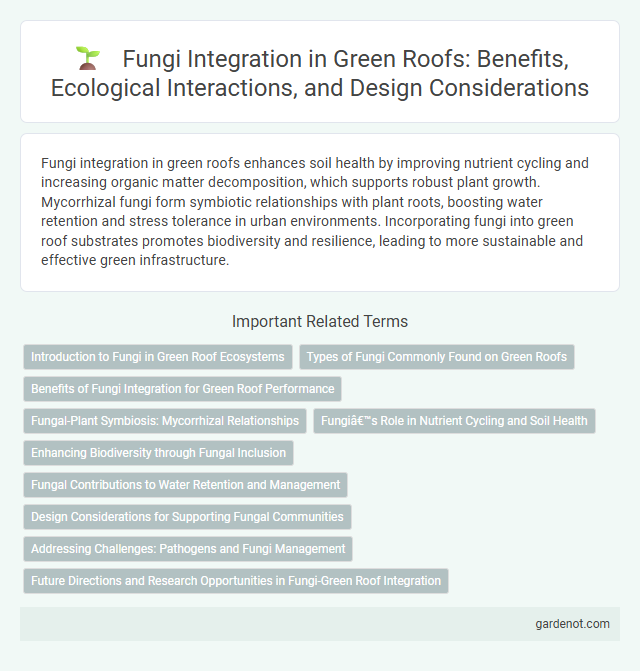Fungi integration in green roofs enhances soil health by improving nutrient cycling and increasing organic matter decomposition, which supports robust plant growth. Mycorrhizal fungi form symbiotic relationships with plant roots, boosting water retention and stress tolerance in urban environments. Incorporating fungi into green roof substrates promotes biodiversity and resilience, leading to more sustainable and effective green infrastructure.
Introduction to Fungi in Green Roof Ecosystems
Fungi play a crucial role in green roof ecosystems by enhancing soil health and plant growth through mycorrhizal associations that improve nutrient uptake and water retention. These symbiotic fungi break down organic matter, enriching the substrate with essential nutrients and promoting a balanced microbial community. Integrating fungi into green roofs increases biodiversity and resilience, supporting sustainable urban environments.
Types of Fungi Commonly Found on Green Roofs
Types of fungi commonly found on green roofs include mycorrhizal fungi, which form symbiotic relationships with plant roots, enhancing nutrient uptake and promoting plant health. Saprophytic fungi play a vital role in decomposing organic matter, contributing to soil fertility and carbon cycling within the rooftop ecosystem. Additionally, endophytic fungi colonize plant tissues, providing increased resistance against environmental stressors and pathogens.
Benefits of Fungi Integration for Green Roof Performance
Fungi integration in green roofs enhances soil structure and nutrient cycling, promoting healthier plant growth and improved water retention. Mycorrhizal fungi form symbiotic relationships with plant roots, increasing resistance to drought and environmental stress by enhancing nutrient uptake. This biological synergy reduces maintenance costs and supports sustainable green roof ecosystems by improving overall system resilience and productivity.
Fungal-Plant Symbiosis: Mycorrhizal Relationships
Mycorrhizal relationships play a crucial role in green roof ecosystems by enhancing plant nutrient uptake and improving soil structure through fungal hyphae networks. These symbiotic fungi facilitate the absorption of phosphorus and trace minerals, boosting plant health and resilience against environmental stressors. Integrating mycorrhizal fungi in green roofs supports sustainable vegetation growth and promotes biodiversity within urban landscapes.
Fungi’s Role in Nutrient Cycling and Soil Health
Fungi play a crucial role in nutrient cycling and soil health within green roof ecosystems by breaking down organic matter and converting it into bioavailable nutrients. Mycorrhizal fungi form symbiotic relationships with plant roots, enhancing nutrient uptake and improving water retention in the substrate. This symbiosis increases soil fertility, promotes plant growth, and supports long-term sustainability of green roofs.
Enhancing Biodiversity through Fungal Inclusion
Fungal inclusion in green roofs significantly enhances biodiversity by promoting symbiotic relationships with plants, improving soil health, and increasing nutrient cycling efficiency. Mycorrhizal fungi facilitate robust root development and stress resilience in rooftop vegetation, creating a more stable and diverse ecosystem. Integrating diverse fungal species supports urban biodiversity while boosting green roof sustainability and ecological function.
Fungal Contributions to Water Retention and Management
Fungi play a crucial role in green roof systems by enhancing water retention through their extensive mycelial networks, which improve soil structure and increase porosity. These networks facilitate better moisture absorption and redistribution, reducing runoff and promoting sustained plant hydration. Integrating specific fungal species can optimize water management, resulting in more resilient and efficient green roof ecosystems.
Design Considerations for Supporting Fungal Communities
Designing green roofs to support fungal communities involves selecting substrates with high organic matter content and appropriate moisture retention to foster mycorrhizal fungi growth. Incorporating diverse plant species with compatible root systems enhances symbiotic relationships between fungi and vegetation, improving nutrient cycling and soil structure. Proper drainage and aeration are critical to maintaining optimal fungal activity and preventing anaerobic conditions that can harm fungal populations.
Addressing Challenges: Pathogens and Fungi Management
Effective fungi integration in green roofs requires advanced pathogen management strategies to prevent harmful mold growth and structural decay. Utilizing beneficial mycorrhizal fungi enhances plant nutrient uptake while suppressing pathogenic species, promoting a balanced microbial ecosystem. Regular monitoring combined with organic fungicides maintains fungal populations within safe thresholds, ensuring green roof longevity and ecological health.
Future Directions and Research Opportunities in Fungi-Green Roof Integration
Future research in fungi-green roof integration should explore species-specific symbiotic effects on plant health and substrate stability to enhance ecosystem services. Investigating mycelium-based biofilters could improve air quality and water retention, addressing urban environmental challenges. Advanced genomic studies and field trials will enable optimization of fungal inoculants for sustainable, resilient green roof systems.
Fungi integration Infographic

 gardenot.com
gardenot.com